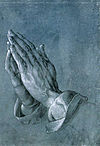Buddhism and Christianity
| Part of a series on |
| Christianity |
|---|
 |

Christianity and Buddhism are both major world religions.
One of the sources of controversy has been the dating of the texts, both Buddhist and Christian.
The use of rosaries spread from India to Europe during the Crusades through the Islamic versions. [1]
When the Catholic missionary Francis Xavier started preaching to the Japanese, he used the word Dainichi to inculturate the notion of the Christian God. However, when he learnt that the Japanese used Dainichi for the Buddha Vairocana, he changed to use Deusu from Portuguese and Latin Deus, avoiding confusion of Christianity and Shingon Buddhism. [2]
Prayer with both the palms touching one another is called the "Anjali Mudra" in Indian spiritual traditions, and is a common greeting and prayer posture in all Indian spiritual traditions, including Buddhism, but is absent in Jewish traditions, whose scriptures mention raised or clasped hands.[3] However, we find this prayer position found in Christian art from the middle ages, considered a common prayer posture of Christianity[4]
| Part of a series on |
| Buddhism |
|---|
 |
References
- ^ Crooke, William (1904). Things Indian: Being Discursive Notes on Various Subjects Connected with India. New York: Charles Scribner's Sons. Retrieved 2007-01-14.
- ^ Sansom, Sir George Bailey (1943). Japan: A Short Cultural History. New York: D. Appleton-Century
company. Retrieved 2007-01-14.
{{cite book}}: Cite has empty unknown parameter:|1=(help); line feed character in|publisher=at position 20 (help) - ^ Ciaravino, Helene. How to Pray. Garden City Park, NY: Square One.
- ^ Ibid
